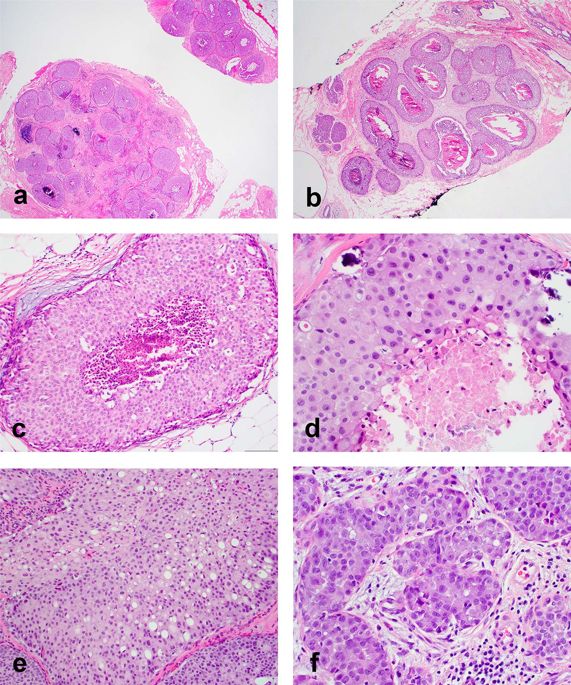当前位置:
X-MOL 学术
›
Modern Pathol.
›
论文详情
Our official English website, www.x-mol.net, welcomes your feedback! (Note: you will need to create a separate account there.)
Genomic profiling of pleomorphic and florid lobular carcinoma in situ reveals highly recurrent ERBB2 and ERRB3 alterations.
Modern Pathology ( IF 7.5 ) Pub Date : 2020-01-13 , DOI: 10.1038/s41379-020-0459-6 Beth T Harrison 1 , Faina Nakhlis 2, 3 , Deborah A Dillon 1, 3 , T Rinda Soong 4 , Elizabeth P Garcia 5 , Stuart J Schnitt 1, 3 , Tari A King 2, 3
Modern Pathology ( IF 7.5 ) Pub Date : 2020-01-13 , DOI: 10.1038/s41379-020-0459-6 Beth T Harrison 1 , Faina Nakhlis 2, 3 , Deborah A Dillon 1, 3 , T Rinda Soong 4 , Elizabeth P Garcia 5 , Stuart J Schnitt 1, 3 , Tari A King 2, 3
Affiliation

|
Pleomorphic LCIS (P-LCIS) and florid LCIS (F-LCIS) are morphologic variants distinguished from classic LCIS by marked nuclear pleomorphism and/or an expansile growth pattern with or without necrosis. Given the rarity of these LCIS variants, little data exist regarding their molecular pathogenesis, natural history, and optimal management. The purpose of this study was to genomically profile LCIS variants to gain further insight into their biology. Nineteen cases of pure LCIS variants (17 P-LCIS, 2 F-LCIS) diagnosed on core needle biopsy at our institution from 2006 to 2017 were included, five of which were upgraded to invasive cancer at excision. Macrodissected lesions were analyzed by a hybrid-capture next generation sequencing assay that surveyed exonic sequences of 447 genes for mutations and copy number variations (CNVs) and 191 regions across 60 genes for structural rearrangements. LCIS variants were all confirmed as E-cadherin negative by immunohistochemistry. Receptor profiles among the 17 P-LCIS cases included HR+/HER2- (nine cases), HR+/HER2+ (three cases), HR-/HER2+ (two cases), and HR-/HER2- (three cases). The two F-LCIS cases were HR+/HER2- and HR+/HER2+. All LCIS variants had genetic alterations consistent with a lobular phenotype including 1q gain (16 cases), 16q loss (18 cases), and CDH1 mutations (18 cases). Highly recurrent ERBB2 alterations were noted including mutations (13 cases) and amplifications (six cases). Other significant alterations included mutations in PIK3CA (six cases), RUNX1 (four cases), ERBB3 (four cases), and CBFB (three cases), as well as amplification of CCND1 (five cases). A TP53 mutation was identified in one case of HR-/HER2+ P-LCIS with signet ring cell features that lacked 1q gain and 16q loss. P-LCIS and F-LCIS contain genetic alterations characteristic of lobular neoplasia; however, these LCIS variants are distinguished from classical LCIS reported in the literature by their highly recurrent ERBB2 alterations.
中文翻译:

原位多形性和红色小叶癌的基因组分析揭示了高度复发的 ERBB2 和 ERRB3 改变。
多形性 LCIS (P-LCIS) 和华丽 LCIS (F-LCIS) 是与经典 LCIS 不同的形态学变体,其特征在于显着的核多形性和/或伴有或不伴有坏死的扩张性生长模式。鉴于这些 LCIS 变异的罕见性,关于它们的分子发病机制、自然史和最佳管理的数据很少。本研究的目的是对 LCIS 变体进行基因组分析,以进一步了解它们的生物学特性。纳入 2006 年至 2017 年在我们机构通过核心穿刺活检诊断的 19 例纯 LCIS 变体(17 例 P-LCIS,2 例 F-LCIS),其中 5 例在切除时升级为浸润性癌。通过混合捕获下一代测序分析对宏观解剖的病变进行分析,该分析调查了 447 个基因的外显子序列的突变和拷贝数变异 (CNV) 以及 60 个基因的 191 个区域的结构重排。LCIS 变体均通过免疫组织化学确认为 E-钙粘蛋白阴性。17 例 P-LCIS 患者的受体谱包括 HR+/HER2-(9 例)、HR+/HER2+(3 例)、HR-/HER2+(2 例)和 HR-/HER2-(3 例)。两个 F-LCIS 病例分别为 HR+/HER2- 和 HR+/HER2+。所有 LCIS 变体都具有与小叶表型一致的遗传改变,包括 1q 增加(16 例)、16q 丢失(18 例)和 CDH1 突变(18 例)。注意到高度复发的 ERBB2 改变,包括突变(13 例)和扩增(6 例)。其他显着改变包括 PIK3CA(6 例)、RUNX1(4 例)、ERBB3(4 例)和 CBFB(3 例)的突变,以及 CCND1(5 例)的扩增。在 1 例 HR-/HER2+ P-LCIS 患者中发现了 TP53 突变,印戒细胞特征缺乏 1q 增益和 16q 缺失。P-LCIS 和 F-LCIS 包含小叶瘤形成的遗传改变特征;然而,这些 LCIS 变体与文献中报道的经典 LCIS 的区别在于它们高度复发的 ERBB2 改变。P-LCIS 和 F-LCIS 包含小叶瘤形成的遗传改变特征;然而,这些 LCIS 变体与文献中报道的经典 LCIS 的区别在于它们高度复发的 ERBB2 改变。P-LCIS 和 F-LCIS 包含小叶瘤形成的遗传改变特征;然而,这些 LCIS 变体与文献中报道的经典 LCIS 的区别在于它们高度复发的 ERBB2 改变。
更新日期:2020-01-14
中文翻译:

原位多形性和红色小叶癌的基因组分析揭示了高度复发的 ERBB2 和 ERRB3 改变。
多形性 LCIS (P-LCIS) 和华丽 LCIS (F-LCIS) 是与经典 LCIS 不同的形态学变体,其特征在于显着的核多形性和/或伴有或不伴有坏死的扩张性生长模式。鉴于这些 LCIS 变异的罕见性,关于它们的分子发病机制、自然史和最佳管理的数据很少。本研究的目的是对 LCIS 变体进行基因组分析,以进一步了解它们的生物学特性。纳入 2006 年至 2017 年在我们机构通过核心穿刺活检诊断的 19 例纯 LCIS 变体(17 例 P-LCIS,2 例 F-LCIS),其中 5 例在切除时升级为浸润性癌。通过混合捕获下一代测序分析对宏观解剖的病变进行分析,该分析调查了 447 个基因的外显子序列的突变和拷贝数变异 (CNV) 以及 60 个基因的 191 个区域的结构重排。LCIS 变体均通过免疫组织化学确认为 E-钙粘蛋白阴性。17 例 P-LCIS 患者的受体谱包括 HR+/HER2-(9 例)、HR+/HER2+(3 例)、HR-/HER2+(2 例)和 HR-/HER2-(3 例)。两个 F-LCIS 病例分别为 HR+/HER2- 和 HR+/HER2+。所有 LCIS 变体都具有与小叶表型一致的遗传改变,包括 1q 增加(16 例)、16q 丢失(18 例)和 CDH1 突变(18 例)。注意到高度复发的 ERBB2 改变,包括突变(13 例)和扩增(6 例)。其他显着改变包括 PIK3CA(6 例)、RUNX1(4 例)、ERBB3(4 例)和 CBFB(3 例)的突变,以及 CCND1(5 例)的扩增。在 1 例 HR-/HER2+ P-LCIS 患者中发现了 TP53 突变,印戒细胞特征缺乏 1q 增益和 16q 缺失。P-LCIS 和 F-LCIS 包含小叶瘤形成的遗传改变特征;然而,这些 LCIS 变体与文献中报道的经典 LCIS 的区别在于它们高度复发的 ERBB2 改变。P-LCIS 和 F-LCIS 包含小叶瘤形成的遗传改变特征;然而,这些 LCIS 变体与文献中报道的经典 LCIS 的区别在于它们高度复发的 ERBB2 改变。P-LCIS 和 F-LCIS 包含小叶瘤形成的遗传改变特征;然而,这些 LCIS 变体与文献中报道的经典 LCIS 的区别在于它们高度复发的 ERBB2 改变。



























 京公网安备 11010802027423号
京公网安备 11010802027423号